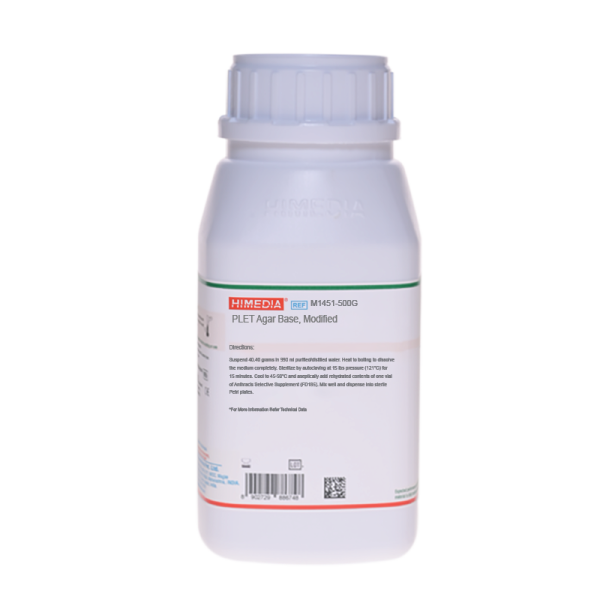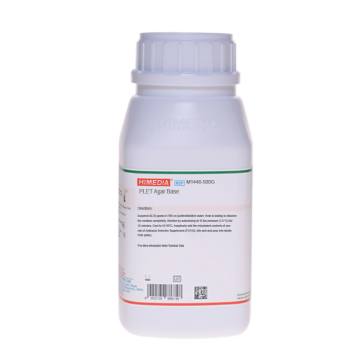 Your enquiry has been submitted
Your enquiry has been submitted
PLET Agar Base, Modified
Intended Use
Recommended for isolation and enumeration of Bacillus anthracis.
Composition**
| Ingredients | g / L |
|---|---|
| HM infusion B from 500 g # | 10.010 |
| Tryptose | 10.000 |
| Sodium chloride | 5.000 |
| EDTA | 0.350 |
| Thallous acetate | 0.040 |
| Agar | 15.000 |
Final pH ( at 25°C): 7.3±0.2
**Formula adjusted, standardized to suit performance parameters # Equivalent to Beef heart, infusion from
Directions
Suspend 40.40 grams in 990 ml purified/distilled water. Heat to boiling to dissolve the medium completely. Sterilize by autoclaving at 15 lbs pressure (121°C) for 15 minutes. Cool to 45-50°C and aseptically add rehydrated contents of one vial of PL Selective Supplement (FD185). Mix well and pour into sterile Petri plates.
Principle and Interpretation
Anthrax is an infectious disease caused by spores of the bacterium Bacillus anthracis. In human anthrax, the Bacillus is usually demonstrable in material from a malignant pustule, sometimes in sputum from pulmonary anthrax and also in the blood in the septicemic stage of all forms of the infections. Man is relatively resistant to anthrax and laboratory workers are rarely infected. However great care should be taken to avoid escape of the long surviving spores into laboratory environment and all the procedures should be carried out in safety cabinet. Anthrax cannot spread directly from human to human but anthrax spores can be transported by human clothings, shoes etc. In humans, anthrax is caused by exposure to dead infected animals, consumptions of infected animal tissue or exposure to light density anthrax spores from animal wool, fur, hide, etc. PLET Agar Base originally formulated by Knisley (1) is the best selective medium for cultivation of B. anthracis (2-4) from suspected environmental specimens, animal products or clinical specimens, inhibiting Bacillus cereus. PLET Agar Base, Modified Medium is similar to base except that it contains increased concentration of EDTA, which helps in inhibiting Staphylococcus aureus. HM infusion B from solids and tryptose provide the carbonaceous and nitrogenous compounds necessary for growth whereas sodium chloride provides the osmotic equilibrium. Thallous acetate and Polymyxin (FD185) are inhibitory agents allowing growth of B. anthracis while inhibiting contaminants. Lysozyme (FD185) specifically suppresses the growth of gram-negative contaminants.
The suspected specimen may be used directly for streaking or heat-treated or alcohol-treated specimens can be used for streaking. On incubation at 37°C for 24 hours colonies develop from 30-100% of the B. anthracis spores that would grow on non-selective HI Agar (M169), being smaller and smoother than on the later medium. PLET Agar Base, Modified inhibits growth of most strains of B.cereus, B. subtilis, other Bacillus species, Enterobacteriaceae and Pseudomonas species. Some strains of B. cereus from soil form colonies but they are smaller than those of B.anthracis, minute after 24 hours and moderately sized after 48 hours. Colonies of B. anthracis appear in 36-40 hours after incubation at 37°C. Roughly circular, creamy- white colonies with a ground-glass texture are further subcultured on blood agar plates for identification. Capsule production can be seen directly or on blood agar plates (2).
Type of specimen
Clinical samples; Environmental specimens
Specimen Collection and Handling
For clinical and environmental samples follow appropriate techniques for handling specimens as per established guidelines (5,6). After use, contaminated materials must be sterilized by autoclaving before discarding.
Warning and Precautions
In Vitro diagnostic use only. For professional use only. Read the label before opening the container. Wear protective gloves/protective clothing/eye protection/ face protection. Follow good microbiological lab practices while handling specimens and culture. Standard precautions as per established guidelines should be followed while handling clinical specimens. Safety guidelines may be referred in individual safety data sheets.
Limitations
- Roughly circular, creamy- white colonies with a ground-glass texture are further subcultured on blood agar plates for identification. Capsule production can be seen directly or on blood agar plates (4).
Performance and Evaluation
Performance of the medium is expected when used as per the direction on the label within the expiry period when stored at recommended temperature.
Quality Control
Appearance: Cream to yellow homogeneous free flowing powder
Gelling: Firm, comparable with 1.5% Agar gel
Colour and Clarity of prepared medium: Light amber coloured clear to slightly opalescent gel forms in Petri plates
Reaction: Reaction of 4.04% w/v aqueous solution at 25°C. pH : 7.3±0.2
pH: 7.10-7.50
Cultural Response: Cultural characteristics observed after an incubation at 35-37°C for 36-40 hours
| Organism | Growth |
|---|---|
| Bacillus anthracis ATCC 14578 | luxuriant |
| Bacillus cereus ATCC 10876 | inhibited |
| Staphylococcus aureus subsp. aureus ATCC 25923 (00034*) | inhibited |
Key : *Corresponding WDCM numbers.
Storage and Shelf Life
Store between 10-30°C in a tightly closed container and the prepared medium at 2-8°C. Use before expiry date on the label. On opening, product should be properly stored dry, after tightly capping the bottle in order to prevent lump formation due to the hygroscopic nature of the product. Improper storage of the product may lead to lump formation. Store in dry ventilated area protected from extremes of temperature and sources of ignition. Seal the container tightly after use. Product performance is best if used within stated expiry period.
Disposal
User must ensure safe disposal by autoclaving and/or incineration of used or unusable preparations of this product. Follow established laboratory procedures in disposing of infectious materials and material that comes into contact with clinical sample must be decontaminated and disposed of in accordance with current laboratory techniques (5,6).
Reference
- Knisely R.F. 1966, J. Bacteriol, 92:784-786.
- Murray et al, 1999, Manual of Clinical Microbiology, 7th Edition, ASM Press, Washington, D.C.
- Norris J. R., Berkley C.W., Logan N.A., and ODonnell A.G., 1981. In M. P. Starr et al (ed) The Prokaryotes : a Handbook on Habitats, Isolation and Identification of Bacteria, Vol. 2, Springer Verlag, Berlin.
- Parry J.M., Turnbull P.C.B. and Gibson J.R., 1983, A Colour Atlas of Bacillus species. Wolfe Medical Publications, London,United Kingdom.
- Isenberg, H.D. Clinical Microbiology Procedures Handbook 2nd Edition.
- Jorgensen, J.H., Pfaller, M.A., Carroll, K.C., Funke, G., Landry, M.L., Richter, S.S and Warnock., D.W. (2015) Manual of Clinical Microbiology, 11th Edition. Vol. 1.
| Product Name | PLET Agar Base, Modified |
|---|---|
| SKU | M1451 |
| Product Type | Regular |
| Physical Form | Powder |
| Origin | Animal |
| Packaging type | HDPE |
| References | 1.Knisely R.F. 1966, J. Bacteriol, 92:784-786.2.Norris J. R., Berkley C.W., Logan N.A., and ODonnell A.G., 1981. In M. P. Starr et al (ed) The Prokaryotes : a Handbookon Habitats, Isolation and Identification of Bacteria, Vol. 2, Springer Verlag, Berlin.3.Parry J.M., Turnbull P.C.B. and Gibson J.R., 1983, A Colour Atlas of Bacillus species. Wolfe Medical Publications, London,United Kingdom.4.Murray et al, 1999, Manual of Clinical Microbiology, 7th Edition, ASM Press, Washington, D.C. |
| Customized Product Available | No |






